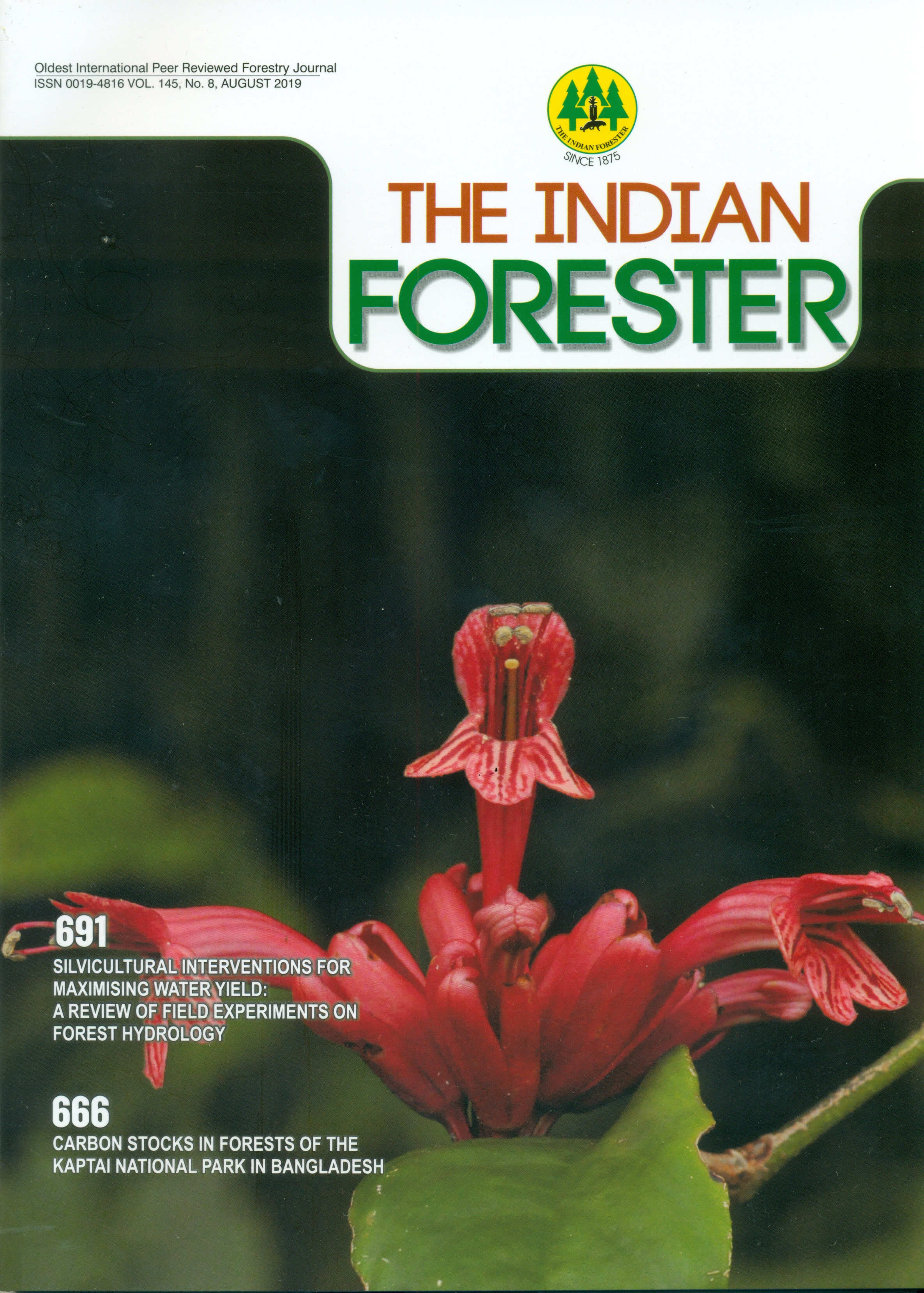Assessment of Forest Dynamics in Chikkamagalur District, Central Western Ghats using Temporal Remote Sensing Data and Spatial Metrics
DOI:
https://doi.org/10.36808/if/2019/v145i8/147119Keywords:
Western Ghats, Chikkamagalur, LULC, Forest Dynamics, Forest Fragmentation, Landscape Structure.Abstract
Forests in the ecologically fragile Western Ghats are undergoing changes in its structure and composition due to irrational policy decisions and mounting human pressure on forest services. Land-use changes in any form potentially result in fragmentation. The extent of the impact will depend on the type of change, the degree of fragmentation, and has effect in terms of patch size, patch shape, connectivity and isolation. This study investigates the spatial patterns of landscape fragmentation dynamics considering temporal data acquired through space borne sensors. Results revealed that forest vegetation has declined from 50.74% (1976) to 36.33% (2009) due to conversion of forests to agriculture, industrial and developmental activities. Encroachment of forest land (22055.59 ha) and conversion to agricultural land is the principal cause of degradation at local level apart from land releases for major developmental activities. Forest fragmentation analysis through spatial metrics shows decline in the interior forest and domination of isolated patches. This study illustrates importance of understanding spatiotemporal patterns of land use changes for sustainable management of tropical forests and help in formulating appropriate conservation measures for the region rich in forest resources.References
Boyle T.J.B. (2001). Interventions to enhance the conservation of biodiversity, In: J. Evans (ed.), The Forest Handbook. Blackwell Science. Oxford, U.K. 82-101pp.
Census of India (2011). http://www.census2011.co.in/census/district/250-chikmagalur.html
Chandran M.D.S. (1998). Shifting cultivation, sacred groves and conflicts in colonial forest policy in the Western Ghats. In: Nature and the Orient: The Environmental History of South and Southeast Asia (Grove R.H., Damodaran V., Sangwan S. eds),Oxford University Press, New Delhi, 674-707pp.
Chikkamagalur District web (2018). http://www.chickmagalur.nic.in/
Daniels R.J.R. (2003), Biodiversity of the Western Ghats: An overview. In: ENVIS Bulletin: Wildlife and Protected Areas, Conservation of Rainforests in India, (A.K. Gupta, Ajith Kumar and V. Ramakantha eds.), 4(1): 25-40.
Forman R.T.T. (1995). Some general principles of landscape and regional ecology. Landscape Ecology, 10: 133-142.
Karnataka State Gazetteer, Government of Karnataka, (1981). Chikmagalur District .
Griffiths G.H., Lee J. and Eversham B.C. (2000). Landscape pattern and species richness, regional scale analysis from remote sensing. Inter. J. Remote Sensing, 21: 2685-2704.
Gururaja K.V. (2004). Sahyadri Mandooka, available at http://wgbis.ces.iisc.ernet.in/biodiversity/sahyadri_enews/newsletter/issue6/index.htm
Gustafson E.J. (1998). Quantifying landscape spatial pattern: what is the state of the art? Ecosystems, 1:143-156.
Houet T. and Verburg P.H. (2010). Monitoring and modelling landscape dynamics. Landscape Ecology, 25:163-167.
Jha C.S. Goparaju L. Tripathi A. Gharai B. Raghubanshi A.S. and Singh J.S. (2005). Forest fragmentation and its impact on species diversity: an analysis using remote sensing and GIS. Biodiversity and Conservation, 14: 1681-1698.
Laurance W.F. Laurance S.G. and Delamonica P. (1998). Worldwide forest campaign news: Tropical forest fragmentation and greenhouse gas emissions. Forest Ecology and Management, 110: 173-180.
O'Neill R.V. Hunsaker C.T. Jones K.B. and Riitters K.H. (1997). Monitoring environmental quality at the landscape scale. Bioscience, 47: 513-519.
Pascal J.P. (1988). Wet Evergreen Forests of the Western Ghats of India: Ecology, Structure, Floristic Composition and Succession, Institut-Francais De Pondicherry, Pondicherry, 345 pp.
Ramachandra T.V., Uttam K., Diwakar P.G. and Joshi N. V. (2009). Land cover Assessment using À Trous Wavelet fusion and K-Nearest Neighbour classification, In: Proceedings of the 25th Annual In-House Symposium on Space Science and Technology, 29-30 January 2009, ISRO-IISc Space Technology Cell, Indian Institute of Science, Bangalore.
Ramachandra T.V. and Uttam K. (2011). Characterisation of Landscape with Forest Fragmentation Dynamics. J. Geographic Information System, 3:242-254.
Ramachandra T.V., Bharath H.A. and Sannadurgappa D. (2012). Insights to Urban Dynamics through Landscape Spatial Pattern Analysis. J. Applied Earth Observation and Geoinformation, 18: 329-343.
Ramachandra T.V., Setturu B. and Chandran S. (2016). Geospatial analysis of forest fragmentation in Uttara Kannada District, India. Forest Ecosystems, 3(1):1-15.
Ritters K., Wickham O'Neill J.R., Jones B. and Smith E. (2000). Global-scale patterns of forest fragmentation. Conservation Ecology, 4(2):1-28.
Roy D.P., Lewis P.E. and Justice C.O. (2002). Burned area mapping using multi-temporal moderate spatial resolution data a bi-directional reflectance model-based expectation approach. Remote Sensing of Environment, 83:263-286.
Saunders D.A., Arnold G.W., Burbridge A.A. and Hopkins A.J.M. (1987). Nature Conservation, the Role of Remnants of Native Vegetation, Surrey Beatty. Chiiping Norton, Sydney, Australia.
Sreekantha, Chandran M.D.S., Mesta D.K., Rao G.R., Gururaja K.V. and Ramachandra T.V. (2007). Fish diversity in relation to landscape and vegetation in central Western Ghats, India. Current Science, 92(11): 1592-1603.
Turner M.G. and Gardner R.H. (1991).Quantitative Methods in Landscape Ecology. Springer-Verlag, New York, USA.
Vogelmann J.E. (1995). Assessment of forest fragmentation in southern New England using remote sensing and geographic information system technology. Conservation Biology, 9(2):439-449.
Wickham J.D., Jones K.B., Riitters K.H., Wade T.G. and O'Neill R.V. (1999). Transitions in forest fragmentation: implications for restoration opportunities at regional scales. Landscape Ecology, 14: 137-145.
Downloads
Downloads
Published
How to Cite
Issue
Section
License
Unless otherwise stated, copyright or similar rights in all materials presented on the site, including graphical images, are owned by Indian Forester.





